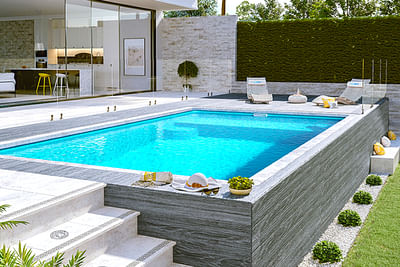In the realm of swimming pool maintenance and renovation, proper pool preparation is the linchpin to achieving an impeccable plaster job. Like a well-oiled machine, each step in the process must be executed with precision and expertise.
From draining the pool to meticulously cleaning the surface, repairing any imperfections, and applying the necessary bonding agents, this article guides you through the intricate art of preparing a pool for a new plaster job.
Follow these procedures diligently to ensure a flawless finish and a lasting pool.
Key Takeaways
- Draining the pool completely is essential for a clean and smooth surface.
- Thoroughly clean and scrub the pool surface to remove contaminants.
- Repair any cracks or damage with a suitable patching compound.
- Applying a bonding agent ensures a strong bond between the old surface and new plaster.
Draining the Pool Completely
To properly prepare a pool for a new plaster job, it is imperative to completely drain the pool. This step is essential in ensuring a clean and smooth surface for the plaster to adhere to. Pool resurfacing prep begins with the removal of all water from the pool, which can be done through the use of a pump or siphoning. Once the pool is drained, it is important to inspect the pool for any remaining water or debris that may have collected in hard-to-reach areas.
After the pool has been drained, the next step in the pool resurfacing prep is cleaning and scrubbing the pool surface. This is done to remove any algae, dirt, or other contaminants that may have accumulated over time. A pressure washer can be used to thoroughly clean the pool surface, ensuring that all residue is removed. It is important to pay special attention to areas where dirt or algae may be more stubborn, such as corners or steps.
Once the pool has been drained and thoroughly cleaned, it is ready for the next steps in the pool resurfacing process. These steps include repairing any cracks or damage, applying a bonding agent to the pool surface, and pre-wetting the pool surface before the plaster is applied. By following these steps, you can ensure that your pool is properly prepared for a new plaster job, resulting in a smooth and durable finish.
Cleaning and Scrubbing the Pool Surface
Firstly, thoroughly clean and scrub the pool surface to remove any algae, dirt, or other contaminants that may have accumulated over time. Proper cleaning and scrubbing of the pool surface is essential to ensure a smooth and clean surface for the plaster to adhere to.
Start by draining the pool completely and removing any debris or loose material from the surface. Use a pressure washer to remove stubborn dirt and algae. Be careful not to damage the pool surface while using the pressure washer.
Next, mix a solution of muriatic acid and water in an acid-resistant bucket. Use a brush or sponge to apply the acid solution to the pool surface. This will help remove any mineral deposits or stains that may have formed on the surface. Rinse the surface thoroughly with clean water after applying the acid solution.
After the acid cleaning, inspect the pool surface for any cracks or damage. Use a grinder or chisel to remove any loose or damaged plaster. Repair any cracks or damage with a suitable patching compound according to manufacturer's instructions.
Once the repairs are complete, rinse the pool surface again with clean water to remove any residual acid or debris. Scrub the surface using a pool brush to ensure all contaminants are removed.
Finally, allow the pool surface to dry completely before proceeding with the plaster application. This will ensure proper adhesion of the plaster and prevent any moisture-related issues.
Cleaning and scrubbing the pool surface is a crucial step in prepping the pool for a new plaster job. By removing any algae, dirt, or other contaminants, you create a clean and smooth surface for the plaster to adhere to, ensuring a high-quality finish.
Repairing Cracks or Damage
Repairing cracks or damage in a pool is a crucial step in preparing for a new plaster job.
Pool damage can occur due to various factors such as age, ground shifts, or improper maintenance.
It is important to assess the type and extent of the damage before determining the repair method and materials to be used.
Importance of Repairing
Before beginning the plaster job, it is crucial to address any cracks or damage in the pool surface. Pool surface repair is an essential step in ensuring a successful and long-lasting plaster job. Neglecting to repair cracks or damage can result in the plaster not adhering properly, leading to future issues such as leaks and deterioration.
To give you a clear understanding of the importance of repairing, let's take a look at the potential consequences of ignoring pool surface repair:
| Consequences of Ignoring Pool Surface Repair | Explanation |
|---|---|
| Water leaks | Unrepaired cracks can allow water to seep through, leading to leaks and water loss. |
| Plaster failure | Damaged areas can cause the plaster to crack or delaminate, compromising its integrity. |
| Structural damage | Cracks can indicate underlying structural issues that, if left unaddressed, can worsen over time. |
| Aesthetic concerns | Unrepaired damage can be unsightly and diminish the overall appearance of the pool. |
Types of Pool Damage
To ensure a successful and long-lasting plaster job, it is important to address the various types of pool damage by repairing cracks or damage in the pool surface. Pool damage can occur due to a variety of reasons such as ground movement, improper installation, or age-related wear and tear.
Common types of pool damage include surface cracks, structural cracks, delamination, and spalling. Surface cracks are shallow and typically do not pose a structural threat, while structural cracks can penetrate deeper into the pool structure and require immediate attention. Delamination refers to the separation of the plaster layer from the underlying pool surface, and spalling refers to the chipping or flaking of the plaster.
Repairing these types of damage is crucial to prevent further deterioration and ensure a smooth and durable plaster job. In the subsequent section, we will discuss the repair methods and materials used for addressing these pool damages.
Repair Methods and Materials
To address the various types of pool damage, it is essential to employ effective repair methods and utilize appropriate materials. When it comes to repairing cracks or damage in a pool, there are several methods and materials that can be used:
- Epoxy Injection: This method involves injecting epoxy into the cracks to fill and seal them, providing a long-lasting repair solution.
- Underwater Patching: For underwater repairs, specialized underwater patching materials can be used to fill and seal cracks or damage without draining the pool.
- Hydraulic Cement: This material is commonly used for repairing larger cracks or damage. It sets quickly and provides a durable repair solution.
- Pool Putty: Pool putty is a versatile material that can be used for both above-water and underwater repairs. It is easy to work with and can be shaped or molded to fit the damaged area.
Applying Bonding Agent to Pool Surface
One crucial step in preparing a pool for a new plaster job is applying a bonding agent to the pool surface. The bonding agent plays a vital role in ensuring a strong bond between the old surface and the new plaster, preventing delamination and ensuring the longevity of the plaster.
Before applying the bonding agent, it is essential to thoroughly clean and scrub the pool surface to remove any dirt, debris, or algae. This can be done using a pressure washer or a mixture of water and muriatic acid. Once the surface is clean, the bonding agent can be applied.
To apply the bonding agent, start by pre-wetting the pool surface with water. This helps to prevent the surface from absorbing the bonding agent too quickly, ensuring a more effective bond. Then, using an acid-resistant bucket and a brush or roller, apply the bonding agent evenly to the entire pool surface.
It is important to follow the manufacturer's instructions when applying the bonding agent, as different products may have specific application requirements. In general, the bonding agent should be applied in a thin, even coat, ensuring that all areas of the pool surface are covered.
After applying the bonding agent, allow it to dry completely before proceeding with the plaster application. This typically takes around 24 hours, but it is important to check the manufacturer's instructions for the specific drying time of the bonding agent being used.
Pre-Wetting Pool Surface Before Plaster Application
Pre-wetting the pool surface before plaster application offers several benefits.
Firstly, it helps to prevent the dry pool surface from absorbing water from the plaster, which can lead to uneven curing and potential cracking.
Secondly, pre-wetting promotes better adhesion between the pool surface and the plaster, ensuring a more durable and long-lasting finish.
To achieve proper pre-wetting, it is important to evenly spray the pool surface with water, ensuring complete coverage and avoiding excessive saturation.
Benefits of Pre-Wetting
Pre-wetting the pool surface before plaster application enhances the adhesion and overall quality of the plaster job. This step is crucial in ensuring a successful pool plastering project.
Here are the benefits of pre-wetting the pool surface:
- Improved hydration: Pre-wetting the pool surface saturates the concrete, preventing it from absorbing excess moisture from the plaster mix. This allows the plaster to hydrate properly, leading to a stronger bond and a more durable finish.
- Reduced cracking: By pre-wetting the pool surface, you minimize the risk of cracks forming during the plaster application. This is because pre-wetting helps to minimize shrinkage and settlement of the plaster, resulting in a smoother and more crack-resistant surface.
- Enhanced workability: Wetting the pool surface before plaster application improves the workability of the plaster mix. This makes it easier for the plasterers to spread and trowel the plaster, ensuring a more even and consistent finish.
- Minimized dusting: Pre-wetting the pool surface helps to reduce dusting, which is the release of fine particles from the plaster surface. This not only improves the appearance of the pool but also enhances the longevity of the plaster.
Proper Pre-Wetting Technique
To ensure optimal adhesion and durability of the plaster job, it is essential to properly pre-wet the pool surface before plaster application. Pre-wetting the pool surface helps prevent the dry pool from absorbing too much water from the plaster mix, which can weaken the bond between the plaster and the pool surface. Here is a table demonstrating the proper pre-wetting technique and its benefits:
| Pre-Wetting Technique | Benefits |
|---|---|
| Use a pressure washer | Removes dirt and debris from the surface |
| Spray the surface with water | Ensures the surface is thoroughly wet |
| Avoid excessive pooling of water | Prevents pooling that can dilute the plaster mix |
Mixing and Applying Plaster Coats
The mixing and application of plaster coats is a crucial step in the pool preparation process. Properly mixing and applying the plaster coats ensures a smooth and durable finish for the pool surface. Here are the key steps involved in this process:
- Mixing the plaster: Follow the manufacturer's instructions to mix the plaster accurately. Measure the correct ratio of water to plaster and use a clean bucket or mixer to achieve a consistent mixture. This step is essential to ensure the plaster's integrity and prevent any lumps or inconsistencies.
- Applying the base coat: Start by evenly applying the base coat of plaster to the pool surface. Use a trowel to spread the plaster in a thin and uniform layer. Pay close attention to corners, steps, and other intricate areas to ensure an even application.
- Troweling the plaster: After applying the base coat, use a trowel to smooth out the surface. This step helps eliminate any imperfections and creates a more polished finish. Trowel the plaster in a circular motion, overlapping each stroke to achieve a consistent texture.
- Applying the final coat: Once the base coat has cured, it's time to apply the final coat of plaster. Apply this coat with precision, ensuring an even and smooth finish. Use the trowel to achieve the desired texture and eliminate any blemishes.
Frequently Asked Questions
How Long Does It Typically Take for the Base Coat of Plaster to Cure Before Applying the Finish Coat?
The base coat of plaster typically takes around 7-10 days to cure before applying the finish coat. This curing period allows the plaster to dry and harden properly, ensuring a strong and durable surface.
It is important to follow the manufacturer's instructions and wait for the recommended curing time before proceeding with the next coat. Rushing the process can result in poor adhesion and a compromised finish.
Patience and careful adherence to proper curing procedures are crucial for achieving a successful plaster job.
Can I Use a Different Type of Plaster Mix Than What the Manufacturer Recommends?
Using a different type of plaster mix than what the manufacturer recommends is not recommended. Manufacturers provide specific instructions and recommendations for a reason, as their products have been tested and formulated to provide optimal results.
Deviating from these recommendations may result in a subpar plaster job, affecting the durability, appearance, and longevity of the pool surface.
It is essential to follow the manufacturer's guidelines to ensure a successful and long-lasting plaster job.
Is It Necessary to Hire a Professional for Pool Maintenance, or Can I Do It Myself?
It is important to assess the complexity and scope of pool maintenance tasks before deciding if hiring a professional is necessary.
While basic maintenance tasks such as cleaning and pH level monitoring can be done by homeowners, professional assistance may be required for more complex issues like equipment repair or water chemistry balancing.
Professionals have the expertise and specialized tools to ensure proper maintenance and prevent potential damage.
A thorough evaluation of your own skills and the specific needs of your pool is recommended before making a decision.
What Are the Consequences of Not Balancing the Pool's Chemical Levels After Plaster Application?
Not balancing the pool's chemical levels after plaster application can have several consequences.
Firstly, it can lead to the deterioration of the plaster, causing it to deteriorate more quickly and potentially develop cracks.
Secondly, unbalanced chemical levels can result in the growth of algae and other harmful bacteria, which can negatively impact the water quality and pose health risks.
Lastly, improper chemical balance can also affect the efficiency of pool equipment and increase maintenance costs.
Therefore, it is crucial to regularly monitor and adjust the pool's chemical levels for optimal pool maintenance.
Are There Any Specific Permits or Regulations That I Need to Be Aware of Before Starting a New Plaster Job?
Before starting a new plaster job for your pool, it is important to be aware of any specific permits or regulations that may be required. Depending on your location, there may be local building codes or permit requirements that dictate the process of pool preparation and plaster application.
It is recommended to consult with your local authorities or a professional in the swimming pool industry to ensure compliance with all necessary permits and regulations before beginning the project.




